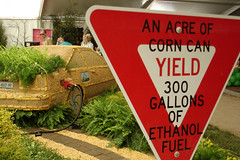Muddled thinking in ostensible defense of the asphalt nation
 Flickr photo from the Cincinnati Flower Show by mrobenalt.
Flickr photo from the Cincinnati Flower Show by mrobenalt.From Cycleicio.us
Hillary Clinton wants half of all US gas stations to sell E85 by 2015. Robert @ The Oil Drum crunched some numbers and came to this conclusion:
Our annual gasoline consumption is up to almost 140 billion gallons. That means on a BTU equivalent basis, converting the entire US corn crop into ethanol would amount to 13.4% of our annual gasoline demand. It takes 77,228 BTUs of fossil fuel inputs to make 83,961 BTUs of "green, renewable" ethanol. That means that in reality, using our entire corn crop would only displace 1% of our annual gasoline consumption. We can't possibly produce enough E85 to justify putting in all those pumps.
Cycleicio.us readers are a smart bunch, so you already know that Hillary talked about cellulosic ethanol, which can be made from switchgrass (among other things). I crunched the numbers before on cellulosic ethanol and switchgrass, figuring we need over 500 million acres of switchgrass to create enough ethanol to replace what we burn today. This commentor came up with a similar number. This comment is also good to read regarding some of the reality that we encounter when trying to figure out a way to fuel our automobiles.
Note that 500 million acres is 781,250 square miles. The continental United States totals 3,098,489 square miles. So switchgrass for gas would require about 1/4 of the land area of the continental U.S.
People will go to great efforts to defend sprawl.
Gasoline is a particularly efficient way to power cars. Alternatives aren't. One of the best ways to provide alternative "energy sources" for transportation and mobility is to get around in ways that are not automobile-dependent.
Index Keywords: energy



0 Comments:
Post a Comment
<< Home